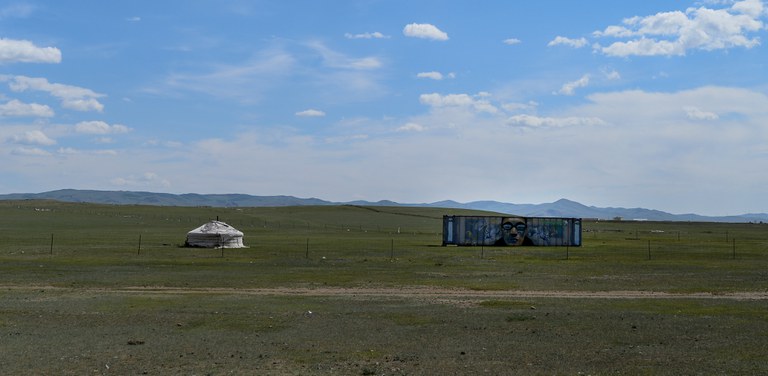In the remote Govi steppe, Mongolian herder Orkhontuya Oyun and her husband constantly move with their livestock in search of rain.
“We lost 600 goats and sheep last winter. They were too weak to survive, even though we brought them inside our tents,” said Orkhontuya, some 300 kilometers (185 miles) north of their home in Ömnögovi in southern Mongolia.
In previous years, Orkhontuya did not have to move further than 40-50 kilometers (18-25 miles) from her area. After an extremely bitter winter, a sweltering summer has begun on the Mongolian steppe, as the semi-arid grassland is known.
“We are now looking for rain, heading to wherever we hear it’s expected to fall,” Orkhontuya said as she combed one of her goats with long, smooth strokes.
Wedged between China and Russia, Mongolia is known for its breathtaking landscapes, with snow-capped mountains, pristine rivers and lakes, and sweeping steppes. But the ancient home of Genghis Khan is now facing an environmental crisis.

Bat-ulzii Bat-Erdene, Mongolia’s environment minister, said the annual average air temperature in Mongolia has risen by 2-2.25 degrees Celsius in the last 80 years due to climate change, more than twice the global average.
The country’s permafrost is melting rapidly, and more than a quarter of its 1,200 rivers, streams, lakes and springs vanished over the past decade, according to the environment ministry.
That’s a grim prospect for the third of the 3.3 million population of Mongolia that still lives a nomadic or semi-nomadic lifestyle. Livestock accounts for more than a quarter of the country’s economy.
Millions of livestock have perished
Orkhontuya, 43, said this has been the hardest year she’s experienced yet. Govi is “the frontier of climate change, and we are experiencing it,” she said.
The landscape around her attests to the problem. The soil is parched. Livestock is scattered. On the horizon, there is black dust kicked up by coal mining, which is conducted on a massive scale in Mongolia.
Weather patterns are growing more extreme.

A phenomenon called dzud, which combines a harsh winter with drought, has been occurring more frequently. Winter temperatures drop as low as minus 40 degrees Celsius (minus 40 Fahrenheit).
The last big dzud in 2010 killed 8.5 million, or 20%, of total livestock in Mongolia. More than a million more died in 2016. And where dzuds used to happen just once or twice a decade, now they kill around half a million livestock each year.
E. Munkhtsetseg, head of the meteorology, hydrology and permafrost research lab at the National University of Mongolia, said the impact of climate change on Mongolia’s pastoral economy and the livelihoods of nomadic herders has been “devastating.”
Govi dust storm travels to China
In Orkhontuya’s region, there has been no rain for the past three years. Most of her family members, friends, and neighbors have already left the herding life.
“Govi is not livable. Not anymore,” Orkhontuya said, adding she also wants to “give up, quit the herding life, and go live in the city.”
“But it’s tough to leave everything behind. This is all we have done and all we know,” she said, next to motorized camper trailers, which many herders use these days. They are quicker to move around the steppe than a ger, the traditional and portable Mongolian yurt or tent.

Yet the impacts of extreme weather are also being felt in the city.
In July, more than 20,000 people were displaced in flooding after what was described as the heaviest rainfall in 50 years in the capital Ulaanbaatar. The number of such incidents has increased tenfold in two decades.
The impacts also extend beyond Mongolia’s borders.
In May, China’s environment ministry said that Mongolia was the main source of 12 large-scale sandstorms, China’s worst in five years, in the first quarter of this year, contributing to as much as 70% of the dust particles in Beijing.

Herders are also the problem
Mongolia is three times the size of France and the most sparsely populated country in the world. Two-thirds of the land area is steppe.
Between the 1920s and 1990, when Mongolia was a satellite of the Soviet Union, the state managed livestock as a socialist collective, limiting the number of animals.
Since 1990, due to privatization and the free market, people can own any number of livestock, even though the number of nomadic herders has decreased by more than half.
“The number of livestock has crossed 71 million in Mongolia, which has led to overgrazing,” Bat-Erdene, the environment minister, said.
Officials say that is three times the capacity. Each year, the number increases by 3 million.
The government has floated the idea of sedentary livestock, but experts are against it, saying the traditional migratory lifestyle is better for the environment if done more sustainably.

To fight desertification, the Mongolian government has planned to plant 1 billion trees by 2030, but it lacks forestry experts and nurseries to produce saplings.
Bulgamaa Densambuu, an advisory board member of the National Federation of Pasture User Groups of Herders, said it makes more sense to try and regenerate grassland.
“Mongolia is not a forested country anymore. It is two-thirds steppe,” she said. “So the most dominant landscape should be the grassland.”
And Bulgamaa says that the situation is not beyond repair. According to the federation’s research, 65% of Mongolian rangeland is degraded but not destroyed.
“Ninety percent of that has the potential for recovery alone if only we manage the issues and reduce the livestock number,” she said.
Edited by Mat Pennington.




